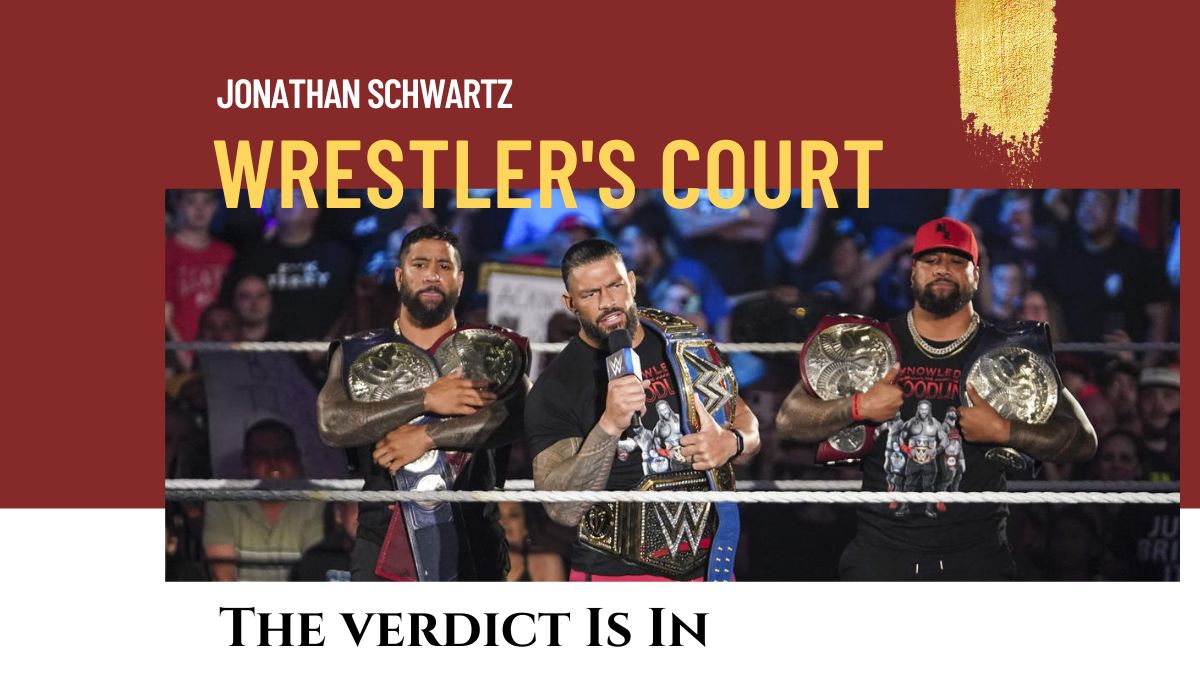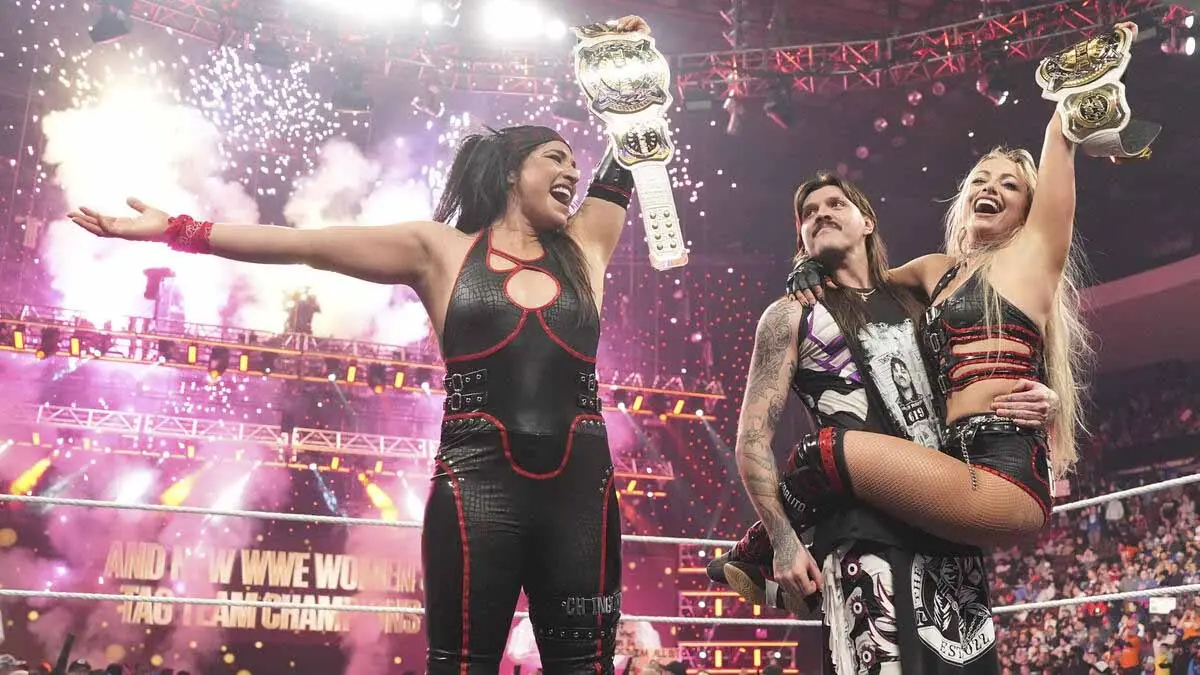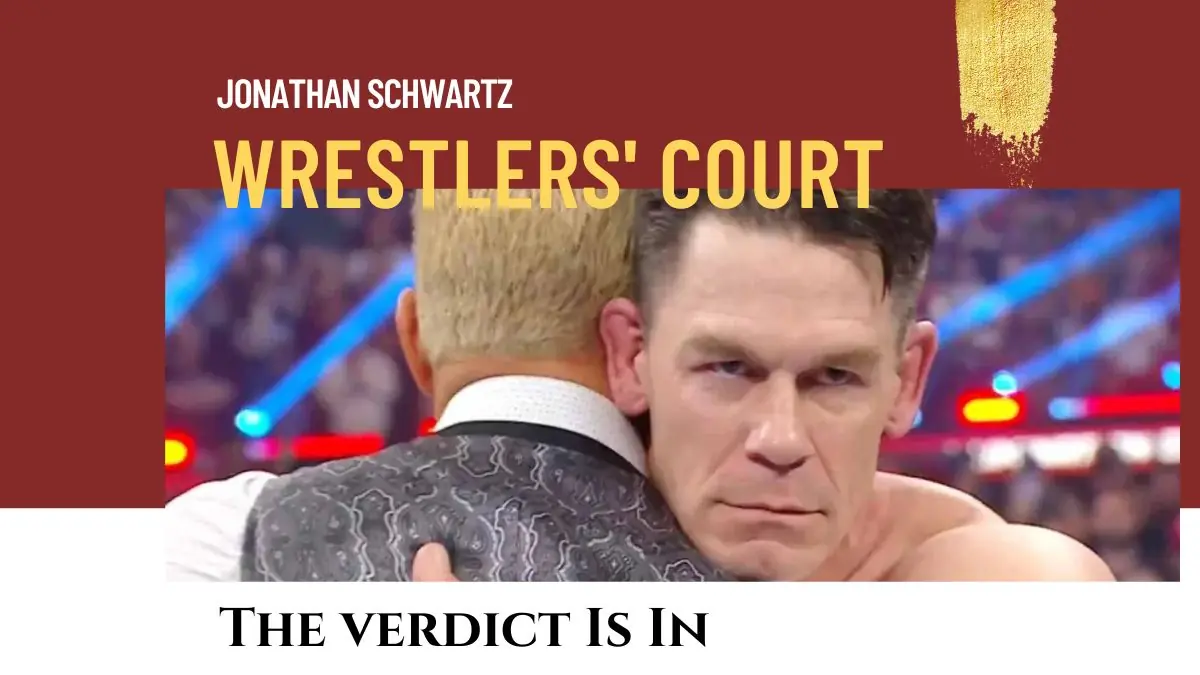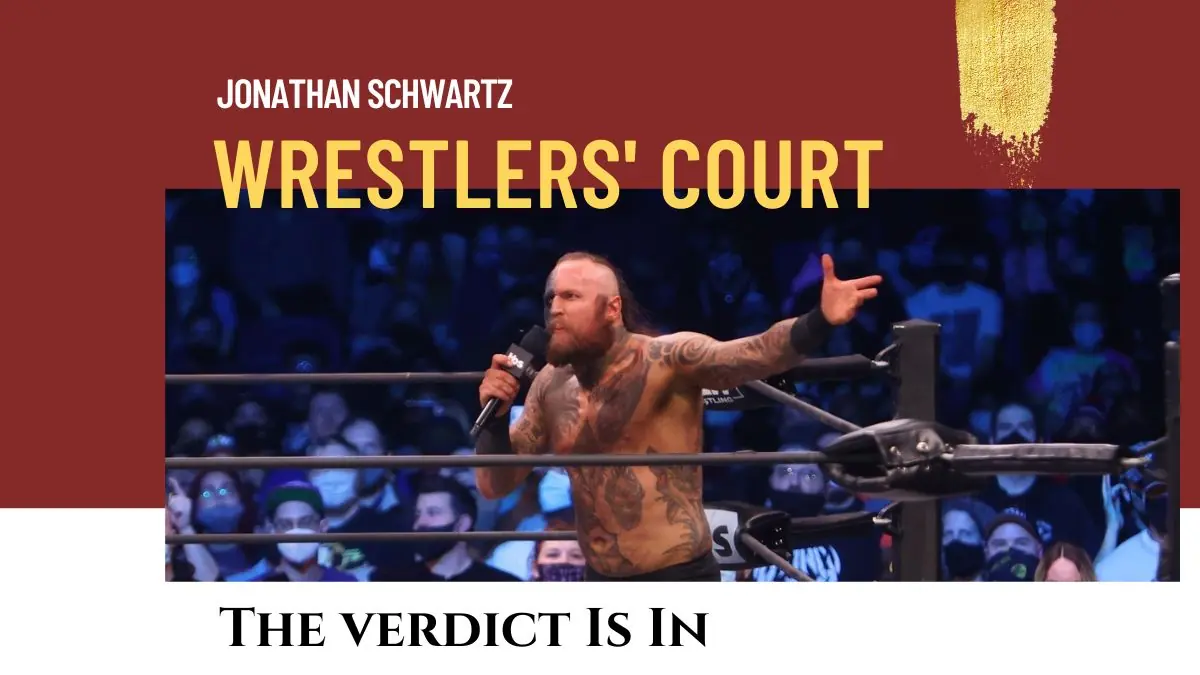The August 24 edition of AEW Dynamite saw CM Punk fight Jon Moxley to re-establish the lineal AEW championship.
Punk had won the belt on May 29 from former champion “Hangman” Adam Page, and almost immediately had to take time off due to injury. Rather than end Punk’s reign as soon as it began, AEW decided to hold a tournament between AEW and NJPW to establish an interim champion. Moxley would beat NJPW’s Hiroshi Tanahashi at the Forbidden Door pay-per-view on June 26 and has defended the interim title thrice. Punk’s reign stood at 86 days without a defense… which is still shorter than the average interval between Roman Reigns’ WWE Universal championship matches.
Fans have questioned the apparent rush of Moxley vs. Punk to an episode of Dynamite rather than holding it off to the upcoming “All Out” Pay-Per-View. The match itself, which saw Moxley thrash Punk in minutes to unify the titles generated even more controversy — online commentators questioned whether Punk was actually injured going into the bout, hurt himself during the contest when planting for a head kick, or was being drummed out of AEW following a rogue ‘shoot’ promo on Adam Page last week and reports that he was difficult to work with.
I suspect and hope that the answer is ‘none of the above.’ Between the announce team calling out Punk’s injury and speculating that he came back too soon, Punk’s writhing sale of his injury and the ref’s failure to stop the bout before Moxley beat Punk with a pair of Death Riders, and the optics of Punk staring back at Moxley triumphant while being helped to the back on one leg, I suspect this flash defeat will be used to cement a Punk heel turn and ignite a bigger feud down the line. It also gives Punk a bit more time to heal up and let backstage politics blow over. Unless you’re a Mox partisan, the match itself felt anti-climactic and considering the energy put into Punk’s comeback (as discussed in my last column) the wrong guy won. If you’re of a certain age and remember the conclusion of WrestleMania IX, where Bret Hart lost to Yokozuna only for Hulk Hogan to swoop in and steal his thunder and the WWE World Championship, you know what I mean. Of course, I’m still waiting for MJF to return from his own exile, so what do I know?

Here endeth my Dynamite rant.
While I understand holding off marquee matches to big shows, I appreciate AEW’s decision to book the unification match now for at least one reason: it takes a belt of the board (even as a Thunder Rosa injury tees up another interim champion). That’s a great thing since in my view the current pro wrestling landscape has entirely too many belts.
Full disclosure: your feelings about the number of belts that a promotion should have will likely be determined by the pro wrestling circuit you grew up with. In my case that’s primarily 1980s WWF, where a stacked roster competed for the World, Intercontinental and Tag Team titles (with occasional appearances by the Women’s and Women’s tag titles… which were often little more than props for singular stars rather than fully fleshed out women’s divisions like we have today). Titles changed hands rarely; most reigns were measured in months if not years, and there as usually a balance between babyface world champions and heel ‘worker’ Intercontinental and tag champs.
Your mileage may vary. The NWA Wrld championship was routinely split between regional titleholders, resulting in phantom title changes, unrecognized champions like Killer Kowalski, Edouard Carpentier, Bruno Sammartino (!) and Bobo Brazil. The WWWF would emerge from the NWA’s shadow following a dispute over who should be champion — the flashy heel Buddy Rogers or the workman Lou Thesz (ultimately settling on Bruno Sammartino as an extended babyface champion when Rogers failed to draw as anticipated; of note, Rogers, Sammartino and Thesz grew to dislike each other as personally as Punk and Page seem to today; kayfabe made their mutual enmity more tolerable). Each promotion ran its own local titles, often a United States (or Canadian/British Commonwealth) and Television and Tag Team champions, plus regional variants.
To be fair, those stuck in a “one belt to rule them all”, “there’s only one world so there should only be one world champion” rut have probably read too many Apter magazines. Titles may be props but they’ve always been money. The traditional good vs. evil battle that animates most professional wrestling matches mean little if the parties don’t have anything to fight over.
The titles symbolized by belts snapped or velcroed around your favorite performers’ waists are the spoils over which they fight, symbols of their holders’ superiority. Pro wrestling may be predetermined, but titles are the physical representation of our suspended disbelief. Their status as props is a line that most performers won’t cross publicly until after retirement. A wrestler who otherwise acknowledges the performance aspect of their craft will insist that titles have value even if the office decides who holds them. To do otherwise would be to create a hole in the wrestling universe. You wouldn’t expect Frodo, in the middle of the Lord of the Rings trilogy to deadpan to the audience “You know this ring, here… doesn’t exist. No Orcs. No Dragons. All of this is fake.” Ditto for Indiana Jones’ Lost Arks and Crystal Skulls, Harry Potter’s Sorcerer’s Stones or Monty Python’s Holy Grails… you get the idea.

Some of the most memorable heel moves involve desecrating championship belts. Mr. Perfect took a hammer to Hulk Hogan’s winged eagle strap on Saturday Night’s Main Event. Madusa Miceli fired a key shot in the Monday Night Wars by dumping the WWF Women’s title in a trash can live on Nitro. Ted DiBiase, frustrated by his inability to beat Hulk Hogan or Randy Savage for their actual WWE championships, commissioned his own Million Dollar Belt (I imagine a certain former US President parades around his golf-courses wearing a replica) in what may just be the greatest moment in wrestling history. It’s worth noting that Madusa’s and DiBiase’s actions still receive callbacks today. Madusa recently rescued the abandoned NXT women’s tag titles while DiBiase’s Million Dollar Belt has been revisited in attempts to get talent including Steve Austin and his own son over… and was more recently the focal point of a fun feud between Cameron Grimes and L.A. Knight.

It stands to reason that more titles give more players stuff to fight about, which makes adding belts tempting for promoters. A new belt gives new impetus for performers who may otherwise be stale or have drifted to the margins. Earlier this summer AEW introduced its version of the Intercontinental Title, the “All Atlantic” belt. The finals to determine the inaugural champion included PAC, Miro and Alastair Black — three talents who have been intermittently featured performers, but who have yet to be booked anywhere close to the main event. PAC, an AEW original who’s time with the company has been limited by visa issues, won.
While WWE an AEW may be criticized for how many belts are defended on its programs this can be partially excused by the number of outlets and bigger rosters it carries. When it suits the promotion, WWE treats Raw, Smackdown and NXT as parallel universes. Notwithstanding the Bloodline’s monopoly on major belts, WWE currently runs 19 titles across four brands. As I write, they are:
WWE Championship
Raw Women’s Championship
United States Championship
Raw Tag Team Championship
24/7 Championship
Universal Championship
Smackdown Women’s Championship
Intercontinental Championship
Smackdown Tag Team Championship
Women’s Tag Team Championship
NXT Championship
NXT Women’s Championship
North American Championship
NXT Tag Team Championship
NXT Women’s Tag Team Championship
NXT United Kingdom Championship
NXT UK Women’s Championship
NXT UK Heritage Cup
NXT UK Tag Team Championship.

A whopping total of 19 championships… and I imagine that most fans, including myself, have trouble remembering who holds which belts, much less their histories. WWE has previously experimented with even more titles, usually when running other acquired promotions in parallel. The relaunched ECW had its own title (although the TV and tag titles never surfaced), and for a while WCW’s belts made regular appearances on WWE TV until that brand was fully subsumed by the awful Alliance storyline (for years, WCW’s big gold belt was a holdover as the WWE World Championship title; the current US title may be the last bit of WCW’s legacy). Smokey Mountain Wrestling, USWA and the late Howard Brody’s NWA titles also had cameo appearances on Raw.
Even if you didn’t grow up in the ‘three title’ era, that’s a lot to keep track of; so much so that WWE has occasionally tried to streamline. In 2001 the Intercontinental, European, US and Hardcore belts were progressively unified until World Champion Triple H beat Kane for the Intercontinental belt. With main American contenders WCW and ECW out of the picture, WWE realized the promised one world, one world champion — Japan and Mexico notwithstanding. Until WWE initiated the first brand split a few months later and the number of titles exploded once again. NXT has recently attempted this on a smaller scale, merging the Cruiserweight and North American titles, and seems poised to do so with NXT UK on the eve of a European reorganization.
I have written before about my belief that AEW owes much of its approach to the old Jim Crockett Promotions/WCW. This includes a drive to create new titles, as though shiny metal plates help cover a thin roster. At points WCW boasted its own World Champion, plus the NWA/International/Big Gold Belt title, a United States Champion, a Television Champion, primary and secondary tag team champs and occasional run-ins like the Mid-Atlantic, National singles and tag, Florida, Central States, Brass Knucks, Junior and Western States Heritage Titles (shoutout to Michael Vee on Facebook for this more comprehensive list). When WCW bought Bill Watts’ UWF, its approach to those belts was a mercy-killing compared to WWE’s handling of WCW and ECW. In later years, WCW would flirt with women’s belts, hardcore titles, light heavyweight and cruiserweight belts — even a cruiserweight tag title that debuted the night WWE bought the company.
AEW has added titles with dizzying frequency in their first three years:
AEW World Championship
AEW All-Atlantic Championship
AEW TNT Championship
AEW World Tag Team Championship
AEW World Trios Championship
AEW Women’s World Championship
AEW TBS Championship
AEW also features the FTW championship, a holdover from ECW most closely associated with former star Taz and now held by his son, Hook. AEW also runs tournaments and battle royals for prizes like the Dynamite Diamond Ring won thrice by MJF or the recent Owen Hart men’s and women’s Cups, which had their own belts (but were not seen on television after a week or two).
This doesn’t take into account the cameos made by other promotions’ belts since AEW started, which includes the NWA Women’s belt when held by Thunder Rosa, the Impact Tag Team Championships in the Good Brothers’ possession, FTR’s current runs with Mexico’s AAA and Japan’s NJPW tag belts, or Kenny Omega wearing enough belts to hold up a Levi’s store’s worth of pants when he held the AAA and Impact World championships in addition to the AEW World championship. One challenging part of the Forbidden Door has been that by acknowledging pro wrestling’s multiverse, it diminishes the value of any given promotion, including its titles. No matter how great a star may be, belts should be earned in the context of the promotion where they’re based.
AEW also has two network shows and four other broadcasts streaming on YouTube. While it hasn’t officially conducted a brand split, its secondary men’s and women’s titles are de facto TV belts, since they bear the name of the networks that carry the product. Adding to the pile, Tony Khan’s purchase of Ring of Honor in the Spring of 2022 introduced a flood of titles with longer histories than AEW’s. While ROH has held pay-per-views under its own name, ROH belts feature prominently on AEW broadcasts. Fan favorites FTR are the current ROH Tag Champs, and Blackpool Combat Club members Claudio Castagnoli and Wheeler Yuta are the promotion’s World and Pure Champions respectfully. Add in TV Champion Samoa Joe, ROH Women’s champion Mercedes Martinez and Six Man titlists Dalton Castle and the Boys (not to be confused with the AEW trios champions who have yet to be crowned) and the number of belts that can be seen on AEW programming effectively doubles — at least until Tony Khan secures an independent path for distribution of his second wrestling promotion (and if he does not, I’d imagine these titles will be short-lived, doomed to be unified or absorbed into AEW as part of its history). Without the formal brand split used by WWE, AEW arguably has the same group of wrestlers competing for 14 different belts… and yet the same few names keep popping up.
In the final analysis WCW should serve as a lesson for AEW and WWE. A title only means as much as the people who hold it. WWE maximized its titles value by swapping them between legends like Sammartino and Hogan and Hart, the Valiants and the British Bulldogs, or Ken Patera and Randy Savage. Later, as titles became fungible and less promoted talents secured reigns, they lost meaning and became distractions. Ricky Steamboat’s or Davey Boy Smith’s runs with the Intercontinental belt were brief but capped key programs and transitioned to more interesting runs for the Honky Tonk Man or Shawn Michaels. I couldn’t tell you off the top of my head who the Godfather beat for his run, or who he lost to (I’ll take Wikipedia’s word that the answers are Goldust and Jeff Jarrett, respectively).
Used properly a title run can elevate a performer to a star and a star to a legend. With too many championships in play, nobody gets elevated and stars aren’t made much less legends.
As AEW prepares to crown its first Trios champions, it is worth noting that the 1980s JCP version of that belt included champions like the Koloffs, the Powers of Pain, the Road Warriors and Dusty Rhodes. By the time WCW got through with it, the last two championship trios were Big Josh, pre-Goldust Dustin Rhodes and Tom Zenk and the York Foundation (heel Ricky Morton, Tommy Rich and Terrance Taylor — you could tell they were bad because they slicked back their hair, that was it).
Without the right person to hold it, a belt just holds up one’s pants.
TOP PHOTO: The Usos and Roman Reigns with a bevy of title belts. WWE photo
RELATED LINK




